#a.d. miles
Text
'Role Models' (2008) film

-watched 4/22/2024- 2 [3/4] stars- on DVD (Netflix)
77% Rotten Tomatoes
#my have seen list#Role Models#(2008)#film#david wain#comedy/drama#paul rudd#seann william scott#elizabeth banks#christopher mintz plasse#bobb'e j. thompson#jane lynch#ken marino#ken jeong#carly craig#alexandra stamler#joe lo truglio#jessica morris#nicole randell johnson#kerri kenney silver#vincent martella#a.d. miles#matt walsh#louis c.k.#zaid farid#cindy sorenson#DVD#Netflix
5 notes
·
View notes
Text
'The Tonight Show' tiene un Nuevo Guionista Principal con el regreso de A.D. Miles y la Salida de Mason Steinberg.

View On WordPress
#A.D. Miles#Chris Miller#Late Night with Jimmy Fallon#Mason Steinberg#The Tonight Show#The Tonight Show Starring Jimmy Fallon#TV
0 notes
Text
stay - a.d




Paring; art x reader
Requested; no
Synopsis; if it was so wrong, why did it feel so right?
Warnings; cheating, possible spoilers i guess
Notes;the brain rot is so bad <3 reqs and inbox are open ! (all requests are being worked on and should be out soon I promise)
Masterlist

Art felt his hands shake slightly as he pulled his shirt over his head. Glancing over his shoulder he watched your chest rise and fall peacefully in your sleep. He felt his breath catch as the feeling of guilt he’d had all morning slowly swirled in his stomach.
He wasn’t someone who cheated. He’d always been faithful, even when he doubted Tashi was as faithful he’d told himself he’d never snoop that low.
Yet here he was. Hastily he grabbed his jeans from the chair and fumbled for a moment before successfully getting them on. Taking a seat on the bed he ran a hand through his hair, letting his head fall into his hands.
The guilt was slowly eating him alive and the worst part wasn’t even that he’d done it. No, the worst part was that he’d enjoyed it.
Letting out a sigh he looked over to you for a moment before shaking his head and standing from the bed.
He knew he had to leave soon. It was easier this way he could leave and then simply act as if nothing happened. Just as his hand pushed the door handle the sound of covers rustling caused him to stop dead.
“You okay? You look a bit skittish?” You rubbed at your eyes yawning softly as you peered over at him. The memories of the night before slowly coming back to you. Art turned to face you, his lip caught between his teeth.
“I’m fine.” He said quietly. His hands felt clammy as he rubbed them together before letting out a shaky breath and making his way back over to the bed. You watched with a slight frown as he sat down, his eyes unwilling to meet yours.
You moved to sit fully pulling the covers over your lap. “You don’t look fine.” You stated drawing his attention back to you. Art simply watched you, his lip still caught between his teeth.
A quiet sigh left your lips as you watched him. You knew what you did was wrong. He was a married man yet you’d willingly let him into your bed and never once tried to stop it.
Yet in the moment it had felt so right. The feel of his lips against your own had been intoxicating and you craved the feeling.
Quietly you moved to sit behind him one of your hands gently rubbing the back of his neck. “She cheated first Art.” You spoke quietly before pressing a soft kiss to his neck. “You just evened the field.”
You knew it was a weak excuse but it was true.
Art felt his face flush at the feeling of your breath on his neck. Goosebumps erupted across his skin as he involuntarily relaxed into your touch, a shaky breath leaving his lips.
He relished in your touch. You were so gentle, treating him as if he was something breakable and his body craved it.
“You're right.” His voice was quiet as he spoke.
“Mhm.” You hummed softly leaning round to press a kiss to his cheek. “You can leave now and I’ll never say a word. We never have to speak of this again.” You trailed a hand down to gently brush against his own and he quickly intertwined his fingers with yours. “Or…you can stay.”
He was still for a moment, his thumb brushing over your hand. He could feel his mind running a hundred miles per hour yet, his heart and body desired to stay.
You held your breath as he turned his attention back to your face. His eyes flickered between your eyes and lips before he whispered. “Stay…”
He turned his body and pressed his chest against yours as he pressed his lips to yours. His hand gently cupped your cheek as you felt your back hit the bed, Art slipping into the spot between your legs.
You knew there was no coming back from this. You both did. Yet…neither of you could find it in you to care.
#challengers#art donaldson#art donaldson fic#art donaldson imagine#art donaldson x reader#art donaldson x you#art challengers#art donaldson drabble#art donaldson fanfiction#art donaldson x female reader#art donaldson fluff#challengers movie#challengers x you#challengers x reader#challengers 2024#tashi donaldson#mike faist#.mine#.challengers#.artdonaldson
701 notes
·
View notes
Text
It's Moon Landing Day!
On this, Tumblr's first celebration of Moon Landing Day, my insomnia and I bring you this humble, barely researched post of fast facts!
On July 20, 1969 at 4:17 p.m. EDT Apollo 11 becomes the first manned spacecraft to land on the moon.
Neil Armstrong (commander), Buzz Aldrin (lunar module pilot) and Michael Collins (command module pilot) were the crew.
The Apollo 11 spacecraft consisted of the command module, Columbia, and the lunar module, Eagle.
The crew traveled 240,000 miles from the Earth to the moon in 76 hours.

1:47 p.m. EDT Armstrong and Aldrin, in the lunar module Eagle, separate from the command module. Collins remains onboard the Columbia orbiting the moon.
4:17 p.m. EDT - The Eagle lands.
4:18 p.m. EDT - “Houston, Tranquility Base here. The Eagle has landed,” Armstrong reports. When the lunar module lands on the moon’s surface at the Sea of Tranquility, it has less than 40 seconds of fuel left.
10:56 p.m. EDT - Armstrong says, “That’s one small step for man, one giant leap for mankind,” as he becomes the first human to set foot on the moon.
11:15 p.m. EDT (approx.) - Buzz Aldrin joins Armstrong on the moon. The men read from a plaque signed by the three crew members and the president, “Here men from the planet Earth first set foot upon the Moon, July 1969 A.D. We came in peace for all mankind.”
11:48 p.m. EDT - President Nixon speaks to Armstrong and Aldrin via radio from the Oval Office, “(it) certainly has to be the most historic telephone call ever made.” They speak for two minutes and the call is televised on both ends.
Armstrong and Aldrin spend over two hours collecting moon rock samples and data, and spend the night on board the Eagle.
Text from CNN, image from USA Today
#moon landing day#of course I'm celebrating#armstrong meant to say#one small step for A man#happy moon landing day to all who celebrate
1K notes
·
View notes
Text
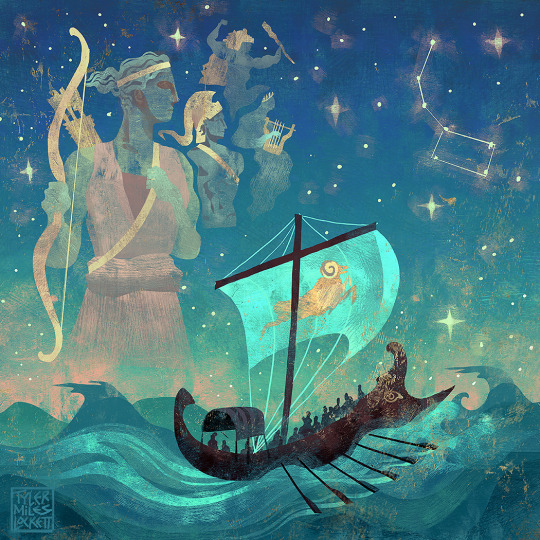
"Atalanta and the Argonauts" (#5)
When the call went out to Greece’s greatest heroes, for fame and glory, to join Jason and his quest for the Golden fleece, only the bravest answered the call. Heroes like Hercules, Orpheus, Telamon, Peleus, and yes, Atalanta mustered her courage and journeyed to join them.
Appollonius of Rhodes wrote the epic poem “Argonautica” about Jason’s quest for the golden fleece around the 3rd century B.C. based on a much older tale, (referenced in Homer and Pindar). Apparently Appollonius elevated the romantic relationship between Jason and Medea, which in turn inspired latin poetry and Virgil’s Aeneid. In Appollonius tale, Atalanta shows up to join the Argonauts, but Jason turns her away, fearing having such a beautiful woman on board would cause conflict between his men. However, In Appollodorus “Library” (1-2nd century A.D.) he lists Atalanta as being one of the heroes who accompany Jason for the Golden fleece. Unfortunately, there are no surviving versions where we see the entirety of the journey with Atalanta involved, which begs the question; what would the adventure be like if Atalanta joined?
On the topic of sea quests, lets take a quick look at ancient Greek seafaring. The Argo ship is portrayed as a sort of Trireme (ancient warship with three rows of oars and curved prow). Developments in astronomy helped ancient sea sailors navigate through constellations like Ursa Minor (little dipper) , as well as moon cycles and eclipses. They also used “sounding weights” to measure sea depths, which helped to inform distances to land. There is evidence from around 100 B.C. of an ancient “Orrery” (solar model) tool for celestial navigation called the Antikythera Mechanism. This ingenious, hand-powered device contained gears and could predict and track astronomical positions and eclipses.
Like this art? It will be in my illustrated book with over 130 other full page illustrations coming in Aug/Sept to kickstarter. to get unseen free hi-hes art subscribe to my email newsletter
Follow my backerkit kickstarter notification page.
Thank you for supporting independent artists! 🤘❤️🏛😁
#greekmythology#greekgods#pjo#mythology#classics#classicscommunity#myths#ancientgreece#argonauts#goldenfleece
114 notes
·
View notes
Text
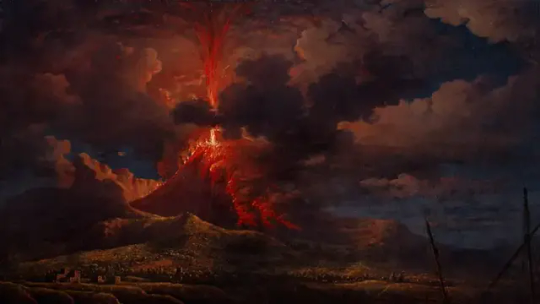
More than 200 Survivors of Mount Vesuvius Eruption Discovered in Ancient Roman Records
After Mount Vesuvius erupted, survivors from the Roman cities of Pompeii and Herculaneum fled, starting new lives elsewhere.
On Aug. 24, in A.D. 79, Mount Vesuvius erupted, shooting over 3 cubic miles of debris up to 20 miles (32.1 kilometers) in the air. As the ash and rock fell to Earth, it buried the ancient cities of Pompeii and Herculaneum.
According to most modern accounts, the story pretty much ends there: Both cities were wiped out, their people frozen in time.
It only picks up with the rediscovery of the cities and the excavations that started in earnest in the 1740s.
But recent research has shifted the narrative. The story of the eruption of Mount Vesuvius is no longer one about annihilation; it also includes the stories of those who survived the eruption and went on to rebuild their lives.
The search for survivors and their stories has dominated the past decade of my archaeological fieldwork, as I’ve tried to figure out who might have escaped the eruption. Some of my findings are featured in an episode of the new PBS documentary, “Pompeii: The New Dig.”
Making it out alive:
Pompeii and Herculaneum were two wealthy cities on the coast of Italy just south of Naples. Pompeii was a community of about 30,000 people that hosted thriving industry and active political and financial networks. Herculaneum, with a population of about 5,000, had an active fishing fleet and a number of marble workshops. Both economies supported the villas of wealthy Romans in the surrounding countryside.
In popular culture, the eruption is usually depicted as an apocalyptic event with no survivors: In episodes of the TV series “Doctor Who” and “Loki,” everyone in Pompeii and Herculaneum dies.
But the evidence that people could have escaped was always there.
The eruption itself continued for over 18 hours. The human remains found in each city account for only a fraction of their populations, and many objects you might have expected to have remained and be preserved in ash are missing: Carts and horses are gone from stables, ships missing from docks, and strongboxes cleaned out of money and jewelry.
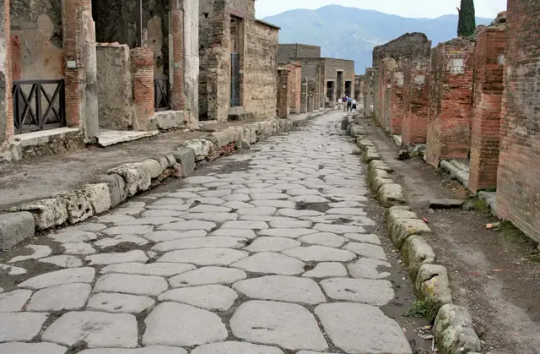
All of this suggests that many – if not most – of the people in the cities could have escaped if they fled early enough.
Some archaeologists have always assumed that some people escaped. But searching for them has never been a priority.
So I created a methodology to determine if survivors could be found. I took Roman names unique to Pompeii or Herculaneum – such as Numerius Popidius and Aulus Umbricius – and searched for people with those names who lived in surrounding communities in the period after the eruption. I also looked for additional evidence, such as improved infrastructure in neighboring communities to accommodate migrants.
After eight years of scouring databases of tens of thousands of Roman inscriptions on places ranging from walls to tombstones, I found evidence of over 200 survivors in 12 cities. These municipalities are primarily in the general area of Pompeii. But they tended to be north of Mount Vesuvius, outside the zone of the greatest destruction.
It seems as though most survivors stayed as close as they could to Pompeii. They preferred to settle with other survivors, and they relied on social and economic networks from their original cities as they resettled.
Some migrants prosper:
Some of the families that escaped apparently went on to thrive in their new communities.
The Caltilius family resettled in Ostia – what was then a major port city to the north of Pompeii, 18 miles from Rome. There, they founded a temple to the Egyptian deity Serapis. Serapis, who wore a basket of grain on his head to symbolize the bounty of the earth, was popular in harbor cities like Ostia dominated by the grain trade. Those cities also built a grand, expensive tomb complex decorated with inscriptions and large portraits of family members.
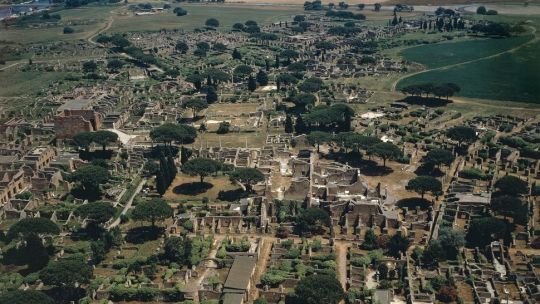
Members of the Caltilius family married into another family of escapees, the Munatiuses. Together, they created a wealthy, successful extended family.
The second-busiest port city in Roman Italy, Puteoli – what’s known as Pozzuoli today – also welcomed survivors from Pompeii. The family of Aulus Umbricius, who was a merchant of garum, a popular fermented fish sauce, resettled there. After reviving the family garum business, Aulus and his wife named their first child born in their adopted city Puteolanus, or “the Puteolanean.”
Others fall on hard times:
Not all the survivors of the eruption were wealthy or went on to find success in their new communities. Some had already been poor to begin with. Others seemed to have lost their family fortunes, perhaps in the eruption itself.
Fabia Secundina from Pompeii – apparently named for her grandfather, a wealthy wine merchant – also ended up in Puteoli. There, she married a gladiator, Aquarius the retiarius, who died at the age of 25, leaving her in dire financial straits.
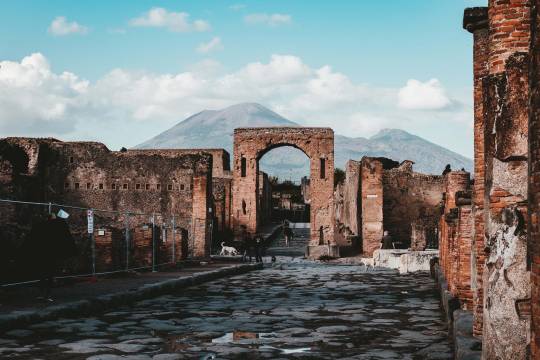
Three other very poor families from Pompeii – the Avianii, Atilii and Masuri families – survived and settled in a small, poorer community called Nuceria, which goes by Nocera today and is about 10 miles (16.1 kilometers) east of Pompeii.
According to a tombstone that still exists, the Masuri family took in a boy named Avianius Felicio as a foster son. Notably, in the 160 years of Roman Pompeii, there was no evidence of any foster children, and extended families usually took in orphaned children. For this reason, it’s likely that Felicio didn’t have any surviving family members.
This small example illustrates the larger pattern of the generosity of migrants – even impoverished ones – toward other survivors and their new communities. They didn’t just take care of each other; they also donated to the religious and civic institutions of their new homes.
For example, the Vibidia family had lived in Herculaneum. Before it was destroyed by the eruption of Vesuvius, they had given lavishly to help fund various institutions, including a new temple of Venus, the Roman goddess of love, beauty and fertility.
One female family member who survived the eruption appears to have continued the family’s tradition: Once settled in her new community, Beneventum, she donated a very small, poorly made altar to Venus on public land given by the local city council.
How would survivors be treated today?
While the survivors resettled and built lives in their new communities, government played a role as well.

The emperors in Rome invested heavily in the region, rebuilding properties damaged by the eruption and building new infrastructure for displaced populations, including roads, water systems, amphitheaters and temples.
This model for post-disaster recovery can be a lesson for today. The costs of funding the recovery never seems to have been debated. Survivors were not isolated into camps, nor were they forced to live indefinitely in tent cities. There’s no evidence that they encountered discrimination in their new communities.
Instead, all signs indicate that communities welcomed the survivors. Many of them went on to open their own businesses and hold positions in local governments. And the government responded by ensuring that the new populations and their communities had the resources and infrastructure to rebuild their lives.
By Steven L. Tuck.
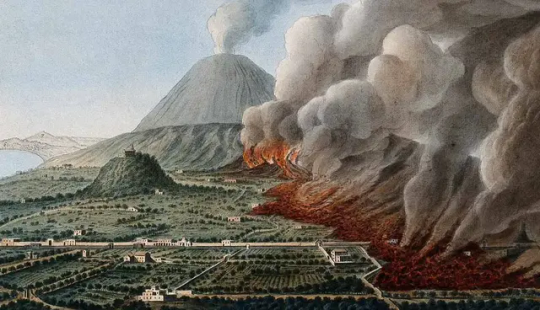
#More than 200 Survivors of Mount Vesuvius Eruption Discovered in Ancient Roman Records#Pompeii#Herculaneum#Mount Vesuvius#ancient artifacts#archeology#archeolgst#history#history news#ancient history#ancient culture#ancient civilizations#roman history#roman empire#long post#long reads
55 notes
·
View notes
Text
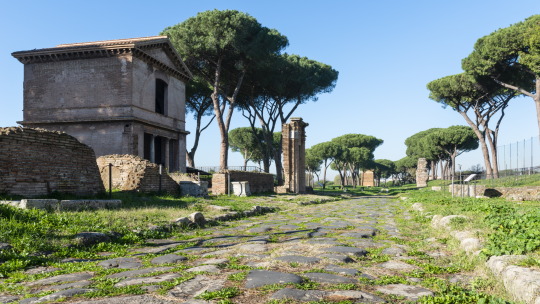
Antigua Via Latina / The ancient Via Latina
In the middle of the Roman periphery, between the modern Via Appia and Via Tuscolana, a section of the 3rd mile of the ancient Via Latina is preserved in perfect condition.
It has ancient origins: the natural route, already followed in prehistoric times, was used by the Etruscans to colonise Campania in the 8th-6th centuries BC.
Definitely laid out by the Romans around the IV-III centuries B.C., it connected Rome with Capua, maintaining its importance throughout Antiquity. In fact, even in the Middle Ages, it was preferred as an access road to Naples because of its better preservation compared to the Appian Way and the presence of a number of Christian places of worship along the route..
Entering the Archaeological Park of the Tombs of the Via Latina, it is now possible to walk along a section of the original paving of the street. With a pleasant walk you can admire the rich tombs dating back to the I-II century A.D. that overlooked the route, which still have perfectly preserved polychrome decorations on the façades and inside: vaults covered with painted plaster and stucco, walls frescoed with funerary scenes and rich mosaic floors are still substantially intact in their original context.
From the street it is also possible to reach the Basilica of S. Stefano, a rare example of an early Christian building erected under the pontificate of Leo the Great in the middle of the 5th century.
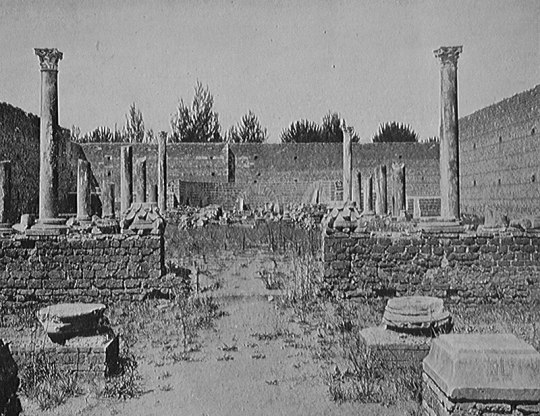
Santo Stefano en Vía Latina, restos parcialmente reconstruidos, 1911.
Santo Stefano in Via Latina, partially reconstructed remains, 1911.
The Archaeological Park of the Tombs of the Via Latina was created in 1879 following the acquisition by the State of a vast area in which important remains from Roman times had been discovered.
BARBERINI TOMB
The so-called Barberini Sepulchre, or Sepulchre of the Corneli. The funerary monument, dating from the 2nd century AD, consists of two above-ground floors and a hypogeum in an excellent state of preservation. The upper floor is covered by a ribbed vault completely covered with plaster painted with a red background and stucco elements. Groups of figures, winged victories on chariots, love affairs, birds, marine animals, mythological themes and architectural backgrounds can be recognised.

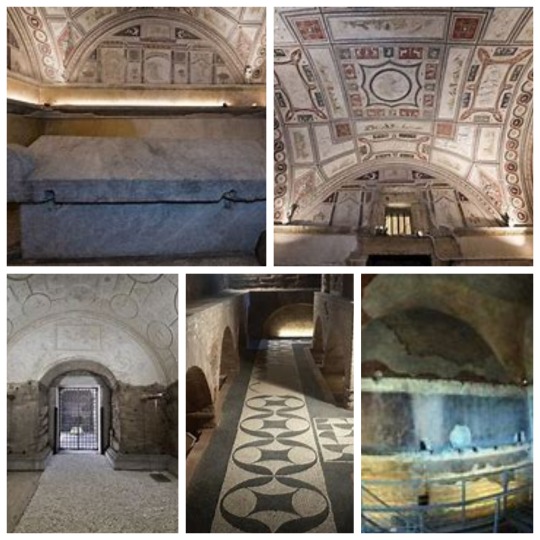
Sepulcro Barberini y su interior / Barberini Tomb and its interior
TOMB OF THE VALERI
The Tomb of the Valeri. The richly decorated underground rooms dating from the mid-2nd century AD are preserved, while the elevation is a hypothetical reconstruction dating from the mid-19th century. An elaborate white stucco covering, articulated in 35 medallions and panels, adorns the lunettes and the barrel vault of the underground room. The medallions depict Dionysian themes, female figures and sea animals, while in the central tondo there is a delicate-veiled figure on the back of a griffin, representing the deceased being carried to the afterlife.
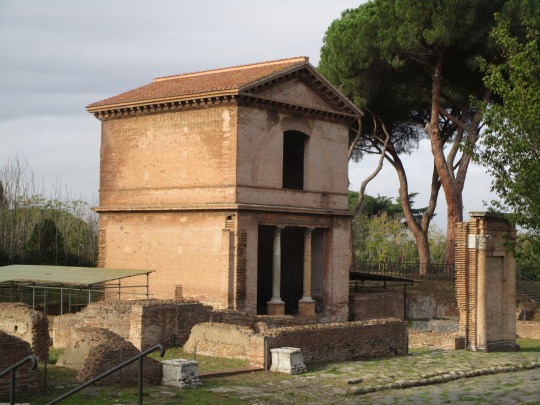
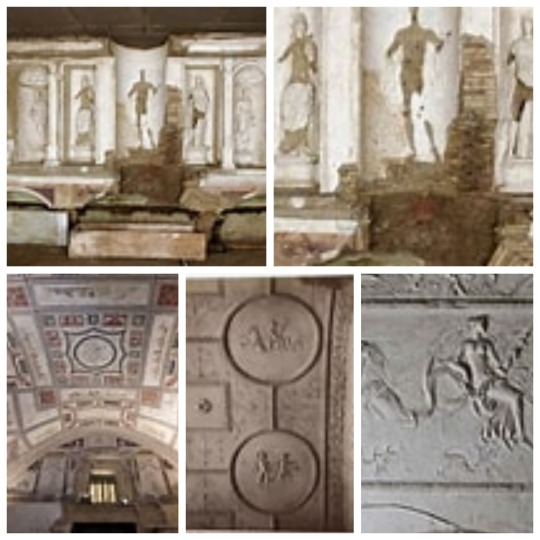
Tumba de los Valeri, exterior e interior / Tomb of the Valeri, exterior and interior
THE TOMB OF THE PANCRATII
The Tomb of the Pancratii. Much of the visible structure is a modern construction that protects the monument below by resting on the original 1st-2nd century AD walls, about a metre high. Upon entering the tomb, one can admire the beautifully decorated underground rooms, with mosaics on the floors and vaults and walls frescoed in bright colours and stucco in an excellent state of preservation. They depict mythological scenes, natural and architectural landscapes, images of women and animals. In the centre of one of the underground chambers is a large sarcophagus for two Greek marble depositions.
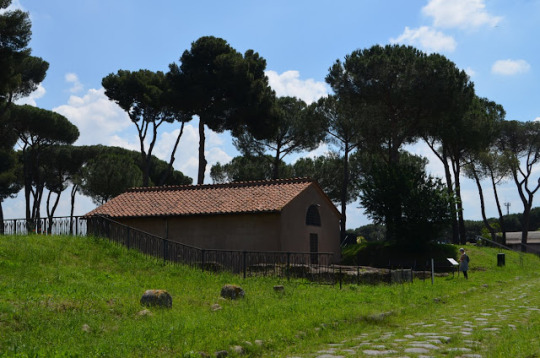
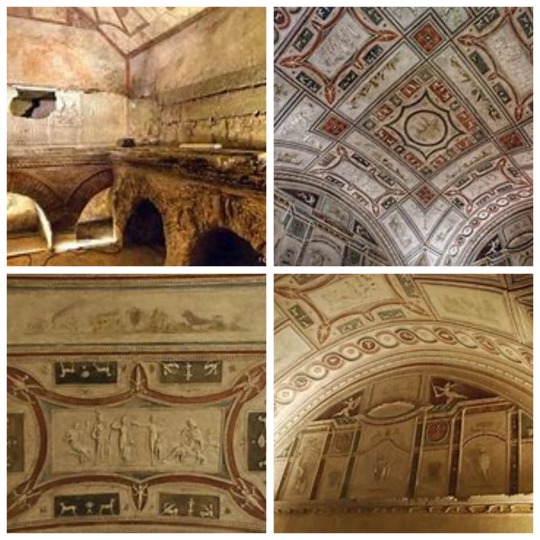
Sepulcro de los Pancracios, exterior e interior / Tomb of the Pancracios, exterior and interior
80 notes
·
View notes
Text
"Beneath 1,350 square miles of dense jungle in northern Guatemala, scientists have discovered 417 cities that date back to circa 1000 B.C. and that are connected by nearly 110 miles of “superhighways” — a network of what researchers called “the first freeway system in the world.”
Scientist say this extensive road-and-city network, along with sophisticated ceremonial complexes, hydraulic systems and agricultural infrastructure, suggests that the ancient Maya civilization, which stretched through what is now Central America, was far more advanced than previously thought.
Mapping the area since 2015 using lidar technology — an advanced type of radar that reveals things hidden by dense vegetation and the tree canopy — researchers have found what they say is evidence of a well-organized economic, political and social system operating some two millennia ago.
The discovery is sparking a rethinking of the accepted idea that the people of the mid- to late-Preclassic Maya civilization (1000 B.C. to A.D. 250) would have been only hunter-gatherers, “roving bands of nomads, planting corn,” says Richard Hansen, the lead author of a study about the finding that was published in January and an affiliate research professor of archaeology at the University of Idaho.
“We now know that the Preclassic period was one of extraordinary complexity and architectural sophistication, with some of the largest buildings in world history being constructed during this time,” says Hansen, president of the Foundation for Anthropological Research and Environmental Studies, a nonprofit scientific research institution that focuses on ancient Maya history.
These findings in the El Mirador jungle region are a “game changer” in thinking about the history of the Americas, Hansen said. The lidar findings have unveiled “a whole volume of human history that we’ve never known” because of the scarcity of artifacts from that period, which were probably buried by later construction by the Maya and then covered by jungle.
Lidar, which stands for light detection and ranging, works via an aerial transmitter that bounces millions of infrared laser pulses off the ground, essentially sketching 3D images of structures hidden by the jungle. It has become a vital tool for archaeologists who previously relied on hand-drawings of where they estimated areas of note might be and, by the late 1980s, the first 3D maps.
When scientists digitally removed ceiba and sapodilla trees that cloak the area, the lidar images revealed ancient dams, reservoirs, pyramids and ball courts. El Mirador has long been considered the “cradle of the Maya civilization,” but the proof of a complex society already being in place circa 1000 B.C. suggests “a whole volume of human history that we’ve never known before,” the study says."
-via The Washington Post, via MSN, because Washington Post links don't work on tumblr for some godawful reason. May 20, 2023.
#maya#mayan#mesoamerica#central america#el mirador#guatemala#indigenous#indigenous history#indigenous peoples#mesoamerican#architecture#ancient history#anti colonialism#fuck racist misconceptions and narratives about indigenous societies and technologies#history#good news#hope
252 notes
·
View notes
Text

ARIZONA INTERESTING FACTS:
1. Arizona has 3,928 mountain peaks and summits, more mountains than any one of the other Mountain States (Colorado, Idaho, Montana, Nevada, New Mexico, Utah, and Wyoming).
2. All New England, plus the state of Pennsylvania would fit inside Arizona.
3. Arizona became the 48th state and last of the contiguous states on February 14, 1912, Valentine’s Day.
4. Arizona's disparate climate can yield both the highest temperature across the nation and the lowest temperature across the nation in the same day.
5. There are more wilderness areas in Arizona than in the entire Midwest. Arizona alone has 90 wilderness areas, while the Midwest has 50.
6. Arizona has 26 peaks that are more than 10,000 feet in elevation.
7. Arizona has the largest contiguous stand of Ponderosa pines in the world stretching from near Flagstaff along the Mogollon Rim to the White Mountains region.
8. Yuma, Arizona is the country's highest producer of winter vegetables, especially lettuce.
9. Arizona is the 6th largest state in the nation, covering 113,909 square miles.
10. Out of all the states in the U.S., Arizona has the largest percentage of its land designated as Indian lands.
11. The Five C's of Arizona's economy are: Cattle, Copper, Citrus, Cotton, and Climate.
12. More copper is mined in Arizona than all the other states combined The Morenci Mine is the largest copper producer in all of North America.
13. Clark Gable and Carole Lombard, two of the most prominent movie stars of Hollywood's Golden Age, were married on March 18, 1939, in Kingman, Arizona.
14. Covering 18,608 sq. miles, Coconino County is the second largest county by land area in the 48 contiguous United States.(San Bernardino County in California is the largest).
15. The world's largest solar telescope is located at Kitt Peak National Observatory in Sells, Arizona.
16. Bisbee, Arizona is known as the Queen of the Copper Mines because during its mining heyday it produced nearly 25 percent of the world's copper. It was the largest city in the Southwest between Saint Louis and San Francisco.
17. Billy the Kid killed his first man, Windy Cahill, in Bonita, Arizona.
18. Arizona grows enough cotton each year to make more than one pair of jeans for every person in the United States.
19. Famous labor leader and activist Cesar Chavez was born in Yuma.
20. In 1912, President William Howard Taft was ready to make Arizona a state on February 12, but it was Lincoln's birthday.
The next day, the 13th, was considered bad luck so they waited until the following day. That's how Arizona became known as the Valentine State.
21. When England's famous London Bridge was replaced in the 1960s, the original was purchased, dismantled, shipped stone by stone and reconstructed in Lake Havasu City, Arizona, where it still stands today.
22. Mount Lemmon, Tucson, in the Santa Catalina Mountains, is the southernmost ski resort in the United States.
23. Rooster Cogburn Ostrich Ranch in Picacho, Arizona is the largest privately-owned ostrich ranch in the world outside South Africa.
24. If you cut down a protected species of cactus in Arizona, you could spend more than a year in prison.
25. The world's largest to-scale collection of miniature airplane models is housed at the library at Embry-Riddle Aeronautical University in Prescott, Arizona.
26. The only place in the country where mail is delivered by mule is the village of Supai, located at the bottom of the Grand Canyon.
27. Located on Arizona's western border, Parker Dam is the deepest dam in the world at 320 feet.
28. South Mountain Park/Preserve in Phoenix is the largest municipal park in the country.
29. Palo Verde Nuclear Generating Station, located about 55 miles west of Phoenix, generates more electricity than any other U.S. power plant.
30. Oraibi, a Hopi village located in Navajo County, Arizona, dates back to before A.D. 1200 and is reputed to be the oldest continuously inhabited community in America.
31. Built by Del Webb in 1960, Sun City, Arizona was the first 55-plus active adult retirement community in the country.
32. Petrified wood is the official state fossil. The Petrified Forest in northeastern Arizona contains America's largest deposits of petrified wood.
33. Many of the founders of San Francisco in 1776 were Spanish colonists from Tubac, Arizona.
34. Phoenix originated in 1866 as a hay camp to supply military post Camp McDowell.
35. Rainfall averages for Arizona range from less than three inches in the deserts to more than 30 inches per year in the mountains.
36. Rising to a height of 12,643 feet, Humphreys Peak north of Flagstaff is the state's highest mountain.
37. Roadrunners are not just in cartoons! In Arizona, you'll see them running up to 17-mph away from their enemies.
38. The Saguaro cactus is the largest cactus found in the U.S. It can grow as high as a five-story building and is native to the Sonoran Desert, which stretches across southern Arizona.
39. Sandra Day O'Connor, the first woman appointed to the U.S. Supreme Court, grew up on a large family ranch near Duncan, Arizona.
40. The best-preserved meteor crater in the world is located near Winslow, Arizona.
41. The average state elevation is 4,000 feet.
42. The Navajo Nation spans 27,000 square miles across the states of Utah, Arizona and New Mexico, but its capital is seated in Window Rock, Arizona.
43. The amount of copper utilized to make the copper dome atop Arizona's Capitol building is equivalent to the amount used in 4.8 million pennies.
44. Near Yuma, the Colorado River's elevation dips to 70 feet above sea level, making it the lowest point in the state.
45. The geographic center of Arizona is 55 miles southeast of Prescott near the community of Mayer.
46. You could pile four 1,300-foot skyscrapers on top of each other and they still would not reach the rim of the Grand Canyon.
47. The hottest temperature recorded in Arizona was 128 degrees at Lake Havasu City on June 29, 1994.
48. The coldest temperature recorded in Arizona was 40 degrees below zero at Hawley Lake on January 7, 1971.
49. A saguaro cactus can store up to nine tons of water.
50. The state of Massachusetts could fit inside Maricopa County (9,922 sq. miles).
51. The westernmost battle of the Civil War was fought at Picacho Pass on April 15, 1862 near Picacho Peak in Pinal County.
52. There are 11.2 million acres of National Forest in Arizona, and one-fourth of the state forested.
53. Wyatt Earp was neither the town marshal nor the sheriff in Tombstone at the time of the shoot-out at the O..K. Corral. His brother Virgil was the town marshal.
54. On June 6, 1936, the first barrel of tequila produced in the United States rolled off the production line in Nogales, Arizona.
55. The Sonoran Desert is the most biologically diverse desert in North America.
56. Bisbee is the Nation's Southernmost mile-high city.
57. The two largest man-made lakes in the U.S. are Lake Mead and Lake Powell, both located in Arizona.
58. The longest remaining intact section of Route 66 can be found in Arizona and runs from Seligman to Topock, a total of 157 unbroken miles.
59. The 13 stripes on the Arizona flag represent the 13 original colonies of the United States.
60. The negotiations for Geronimo's final surrender took place in Skeleton Canyon, near present day Douglas, Arizona, in 1886.
61. Prescott, Arizona is home to the world's oldest rodeo, and Payson, Arizona is home to the world's oldest continuous rodeo, both of which date back to the 1880's.
62. Kartchner Caverns, near Benson, Arizona, is a massive limestone cave with 13,000 feet of passages, two rooms as long as football fields, and one of the world's longest soda straw stalactites: measuring 21 feet 3 inches.
63. You can carry a loaded firearm on your person, no permit required.
64. Arizona has one of the lowest crime rates in the U.S.A.
34 notes
·
View notes
Text
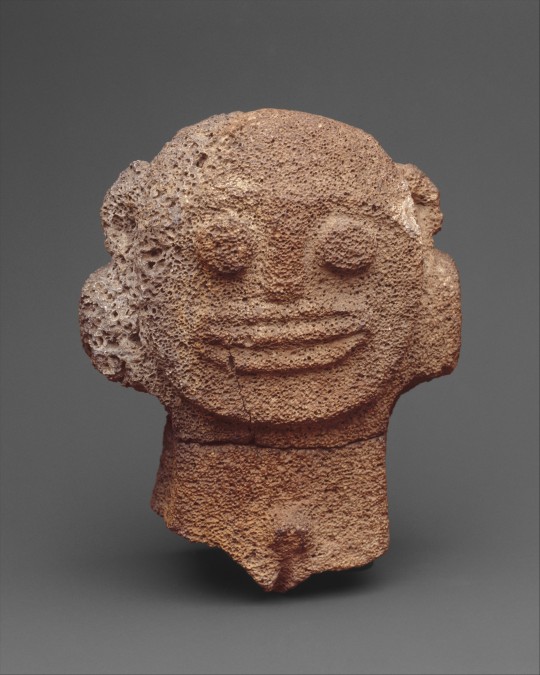
Figure
Hawai'i, 9th–11th century
This enigmatic head and torso is one of a group of eleven stone figures discovered in 1894 on Necker Island, a barren outcrop of rock 300 miles northwest of the Hawai'ian islands. Necker was once inhabited by Polynesian settlers who built temple platforms and carved stone figures from the local basaltic rock, but the island was abandoned several centuries prior to European contact. Therefore, the precise identity and function of the Necker Island figures, which may date from about A.D.1000, is unknown. Because they were found in association with temple platforms, it is likely that the figures are images of gods or deified ancestors that were used during religious ceremonies.
55 notes
·
View notes
Text

The Pulsar Powered Crab - May 31st, 1996.
"In the summer of 1054 A.D., Chinese astronomers reported that a star in the constellation of Taurus suddenly became as bright as the full Moon. Fading slowly, it remained visible for over a year. It is now understood that a spectacular supernova explosion - the detonation of a massive star whose remains are now visible as the Crab Nebula - was responsible for the apparition. The core of the star collapsed to form a rotating neutron star or pulsar, one of the most exotic objects known to 20th century astronomy. Like a cosmic lighthouse, the rotating Crab pulsar generates beams of radio, visible, x-ray and gamma-ray energy which, as the name suggests, produces pulses as they sweep across our view. Using a stunning series of visible light images taken with the Hubble Space Telescope (HST), astronomers have discovered spectacular pulsar powered motions within the Crab nebula. Highlights of this HST Crab "movie" show wisps of material moving away from the pulsar at half the speed of light, a scintillating halo, and an intense knot of emission dancing, sprite-like, above the pulsar's pole. Only 6 miles wide but more massive than the Sun, the pulsar's energy drives the dynamics and emission of the nebula itself, which is more than 10 light-years across. In the HST image above, the pulsar is the left most of the two bright central stars."
39 notes
·
View notes
Text

Researchers and monster hunters are gathering in the United Kingdom's Scottish Highlands this weekend to look for the eternally elusive Loch Ness Monster, the biggest search for the legendary beast in more than 50 years.
Somewhere beneath the shimmering surface of Loch Ness lies Nessie, the legendary sea beast whose reputation spans nearly 1,500 years — at least, that's what monster hunters and Nessie enthusiasts from around the world hope to prove Saturday and Sunday.
The Loch Ness Centre and the research group Loch Ness Exploration are asking all aspiring monster hunters to join in on the biggest search since 1972.
"Our purpose is to observe, record and study the natural behaviour of the Loch and phenomena that may be more challenging to explain," the Loch Ness Exploration Facebook page reads.
"If you believe that the Loch Ness Monster exists then we invite you to join the search, we equally invite you to support the study of the Loch and the natural behaviour of the elements that may be the root cause of these strange reports from Loch Ness."
Investigators are breaking out all sorts of technology, including surveying equipment the Loch Ness Centre says has never been used on the freshwater lake before.
Drones with infrared cameras will fly over the lake and a hydrophone will be used under the surface to detect "Nessie-like calls," the Centre says.
Volunteers will also participate in a large surface watch of the loch, scanning the surface for any irregularities.
However, due to an "overwhelming demand" from enthusiasts, the group is no longer accepting applicants hoping to participate in person.
But the Loch Ness Centre says those still eager to participate can do so virtually through a livestream.
At 22 square miles and with a maximum depth of 788 feet, Loch Ness is Great Britain's largest lake by volume and second-largest by surface area, according to Encyclopedia Britannica.
Though the first written accounts of a monster are attributed to the Irish monk Saint Columba's encounter in 565 A.D., reports of a creature in the lake are depicted in ancient stone carvings found in the area.
But the legend of a monster lurking in the loch didn't garner greater attention until April of 1933, when a couple driving along the newly built road around the lake saw an animal they compared to a "dragon or prehistoric monster," according to the Scottish Maritime Museum.
More sightings soon followed, and big game hunter Marmaduke Wetherell was commissioned to track the monster down in December of 1933.
He said he found large tracks along the shoreline, but zoologists at the Natural History Museum debunked the tracks.
The following year was when English physician Robert Wilson took a photo, now known as the "Surgeon's Photograph," which appeared to show Nessie's head atop a long slender neck poking out of the water.
The picture was printed in the Daily Mail and the Loch Ness Monster was thrust into international stardom.
One of the participants in that search confessed on his deathbed that the picture was staged, according to the Daily Mail.
The Loch Ness Centre says there have been more than 1,140 official Nessie sightings.
Paul Nixon, the Centre's general manager, said he's excited to see what turns up after the waters are searched like never before over weekend.
"We are guardians of this unique story," Nixon said.
"And as well as investing in creating an unforgettable experience for visitors, we are committed to helping continue the search and unveil the mysteries that lie underneath the waters of the famous Loch."
#Loch Ness Monster#Scottish Highlands#Loch Ness#Nessie#Loch Ness Centre#Loch Ness Exploration#Saint Columba#Scottish Maritime Museum#Marmaduke Wetherell#Natural History Museum#Robert Wilson#Surgeon's Photograph#Daily Mail#Paul Nixon
64 notes
·
View notes
Text
@mouseinamushroomhouse you asked me for a Simon Illyan playlist nearly a year ago, and I'm proud to report it is finally done! I hope you and anyone else who listens to it enjoys!! :)
(shoutout to @cookie-nom-nom for suggesting the song Time Machine and @trelldraws for the McCartney and National recs, as well as putting up with me randomly sending various songs and helping figure out which ones fit and didn't. More musings about the process & specifics under the cut!)
With this playlist I really focused on keeping the length down, since I wanted every song to count and ideally keep the whole thing around an hour in length. This resulted in a lot of songs that kind-of-but-not-really fit Simon having to get cut, which was painful but made the fanmix better in the end, and part of the reason why this whole thing took so long, hah. I did however save them all in a separate playlist, so if after listening to the main one y'all want to see what didn't make the cut, feel free to listen here (do know it's not in anything resembling order, though).
With that said, it was a conscious decision to devote 3 whole songs to the chip breakdown, because I feel like while objectively it didn't take up 18% of his life, subjectively in the moment I think it probably felt that way for him.
The first and last songs really serve as bookends to the playlist for me. With the first not even fully a song, rather a spoken word 3rd POV narrative about a robot and last one literally named 'Simon', it felt right thematically about how he sees himself. I'm not sure if we get any explicit musings about the chip from him in that light in canon, but Tej's line about his "super-humanity ... or super-inhumanity" stood out to me in that regard. Especially since it's all but said that he didn't have much of a say in getting it installed in the first place, did he ever feel like the robot people considered him to be? And how did that change?
At the same time, there's so much more to Simon than just his chip, and I hope that shows through the songs I picked as well (if you look at the dates added, you can see I only found 'Until It Kills' yesterday, and that finally completed the playlist for me). I wish I'd found a song that managed to convey him & Miles as a team specifically, but that proved surprisingly difficult as so many songs of that nature seem to be written with a direct parent-child relationship in mind. Still, I'll add it if I ever find it.
ALSO, so damn hard to find songs with spy-related lyrics, I've used so many different search terms and engines and still nearly every result is instrumental music or about a specific incident. I think I have enough in here that it works, and I'm sure those songs exist somewhere, but the internet in all its glory did not choose to reveal them to me (if you know any I'd love to have a listen, I probably won't be adding them to this playlist however as I really just want to be done with this mini-project asdfghjkl).
Edit: aa I forgot to say the one specific thing I wanted to, which is how the line "play dirty" in the song with the same name for me really links back to Galeni's line in Memory: "Damn but Illyan fights dirty when he fights" <3 that's my guy,,
And as said in the description of the playlist, first few songs are very much inspired by the fic Aral Vorkosigan's Dog by Philomytha (since it might as well be canon for me).
And finally, for fun, my top 5 favourite lines that just feel so Simon Illyan to me out of every song in the playlist:
"But no one ever tells you that forever feels like home / Sitting all alone inside your head" - Through Glass by Stone Sour
"With the hands of time around my neck" - Hourglass by Motionless In White
"Nano-electrodes pulse the thrum / One note to beat my heart, beat my heart, like a drum" - Yes I Know by The Pack a.d.
"I testify if I die in my sleep" - Stay Frosty Royal Milk Tea by Fall Out Boy
"Keep them safe inside your home / If it kills you" - Until It Kills by Midtown
If you've read this far, thank you, and do let me know what you think of the playlist and if there are any songs/lines that stood out to you, I'd love to know <3
18 notes
·
View notes
Text

Archeologists have unearthed the lost remains of a Teotihuacan village, including human burials, in the heart of Mexico City.
Ceramics found scattered around the site, which is located 1.5 miles (2.4 kilometers) northwest of the city's historical center, indicate the village dates from around A.D. 450 to 650 and may have housed a community of artisans and craftspeople.
"The finding was surprising," said an archaeologist at Mexico's National Institute of History and Anthropology (INAH) Directorate of Archeological Salvage, who co-led the dig. "It shows that 1,300 years ago, the islets inside Lake Texcoco, on which Mexico City was founded [after the lake was drained], already supported a permanent population that took advantage of the resources of the lake environment," he told Live Science in an email.
The newly excavated settlement may have formed during the "ruralization" of Teotihuacan, an ancient metropolis that flourished in the highlands of what is now central Mexico between A.D. 100 and 650.The village is located 25 miles (40 km) to the southwest of Teotihuacan and may have been one of several small towns that supported themselves through subsistence farming and fishing as the ancient city reached its zenith. These settlements maintained commercial ties to Teotihuacan, and the new discoveries shed light on the role these settlements played in the city's supply network.
"The discovery is rare because it occurred in a fully urbanized context where the possibility of finding archeological evidence associated with the Teotihuacan culture was very low," he added.
Gifted craftspeople
Archeologist Francisco González Rul discovered the first clues of this village's existence in the 1960s, during construction works in the Mexican capital. Based on ceramics he unearthed, González Rul suggested at the time that the inhabitants were self-reliant fishers and gatherers. The new excavations confirmed this.
Several previously unseen architectural structures — including post holes, flooring, channels and an artesian well — as well as ceramics have come to light. The excavation also unearthed three human burials containing the skeletons of two adults and a child.

Teotihuacan was an ancient metropolis that flourished in the highlands of what is now central Mexico.
Teotihuacan ceramics are categorized into phases, according to a 2016 study in the journal PLOS One. The newfound ceramics displayed features that correspond to the Xolalpan (A.D. 350 to 550) and Metepec (A.D. 550 to 600) phases in the 2016 study, which enabled the researchers to date the remains of the village and its inhabitants.
The Teotihuacans were gifted artists and craftspeople, said a professor of archeology and director of the Teotihuacan Research Laboratory at Arizona State University. "To decorate the walls of their houses and temples, the Teotihuacanos used the same fresco technique used by Michealangelo to paint the Sistine Chapel," told the professor Live Science in an email. "They also used the fresco technique on ceramic vessels."
The ceramics could reveal important information about trade with Teotihuacan through chemical analysis, said the professor.
Archeologists have concluded the excavations and are now analyzing the discovered materials and bones. Much of Teotihuacan's sprawling architecture remains buried, but the site is largely unaffected by modern construction and will eventually be unearthed in its entirety.
#🇲🇽#mexican archaeologists#mexico#Francisco González Rul#indigenous#native#Teotihuacan#mexico city#National Institute of History and Anthropology#INAH#Michealangelo#fresco technique#Lake Texcoco
44 notes
·
View notes
Photo

Cueva de las Manos (Spanish for Cave of the Hands) is a cave and complex of rock art sites in Argentina, about 100 miles south of the town of Perito Moreno. It is named for the hundreds of paintings of hands stenciled, in multiple collages, on the rock walls. The art was created in several waves between 7,300 B.C. and 700 A.D., during the Archaic period of pre-Columbian South America.
42 notes
·
View notes
Text

Medusa's Gaze (#6 in my "Quest for the Gorgon Head" series)
Part6:
With his winged sandals, Perseus flies over the sea finally coming to the barren lands of the three Gorgon sisters; the immortals- Stheno and Euryale, and the mortal sister-Medusa. Passing amongst the stony victims of animals and mortals alike, he stealthily descends deep into their lair where they sleep. Using Athena’s shield as a mirror, and invisible due to hades helmet, he quietly floats over to Medusa, rising his Adamantine sickle high for the death stroke. But she hears him! She awakes in rage, unleashing the full terrible power of her gaze upon the intruder!
In the oldest, archaic representations of the gorgon in Greek art (tombs, coins, breastplates, rooms,) the frightening head seems to function as an “apotropaic” symbol (protective amulet) to ward off evil, known as a “Gorgoneian". A fascinating aspect of the portrayal of the gorgon head in Ancient Greek art is that she uniquely portrayed as front facing, strikingly meeting the viewer’s gaze head on. While most other God’s and mortal character’s faces and bodies are shown in side profile views.
there are multiple sources for the stories involving Medusa. In Homer’s Odyssey, the gorgon is vaguely referred to as a frightening head from the underworld. In Hesiod's "Theogany,”(700 B.C. Greece)he increases the number to three sisters, with Medusa being a monster from birth who willingly lays with Poseidon, and resides in the far lands with her Gorgon sisters. It's not until 700 years later, in the Roman Poet Ovid's "Metamorphosis" (8 A.D.) that Medusa is completely reinvented as a beautiful mortal, and chaste priestess of Athena, who, after being raped by Poseidon in Athena’s temple, is cruelly cursed by Athena with snake for hairs and a stony gaze, and then exiled.
Like this art? It will be in my illustrated book with over 130 other full page illustrations coming in June to kickstarter. to get unseen free hi-hes art subscribe to my email newsletter
Follow my backerkit kickstarter notification page.
Thank you for supporting independent artists! 🤘❤️🏛😁
#greekmythology#greekgods#pjo#mythology#classics#classicscommunity#myths#ancientgreece#danae#perseus#medusa#gorgon#athena
68 notes
·
View notes